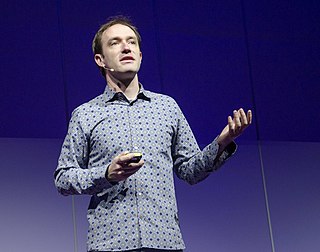Related Research Articles

Edward Fredkin is a distinguished career professor at Carnegie Mellon University (CMU), and an early pioneer of digital physics.

Processing is a free graphical library and integrated development environment (IDE) built for the electronic arts, new media art, and visual design communities with the purpose of teaching non-programmers the fundamentals of computer programming in a visual context.
The Prix Ars Electronica is one of the best known and longest running yearly prizes in the field of electronic and interactive art, computer animation, digital culture and music. It has been awarded since 1987 by Ars Electronica.

Joshua Davis is an American designer, technologist, author, and visual artist in new media.
The actor model in computer science is a mathematical model of concurrent computation that treats an actor as the basic building block of concurrent computation. In response to a message it receives, an actor can: make local decisions, create more actors, send more messages, and determine how to respond to the next message received. Actors may modify their own private state, but can only affect each other indirectly through messaging.
Joanna Berzowska is an Associate Professor of Design and Computation Arts at Concordia University in Montreal. Her work and research deal primarily with "soft computation": electronic textiles, responsive clothing as wearable technology, reactive materials and squishy interfaces.

Emergent is neural simulation software that is primarily intended for creating models of the brain and cognitive processes. Development initially began in 1995 at Carnegie Mellon University, and as of 2014, continues at the University of Colorado at Boulder. The 3.x release of the software, which was known as PDP++, is featured in the textbook Computational Explorations in Cognitive Neuroscience.

Programming language theory (PLT) is a branch of computer science that deals with the design, implementation, analysis, characterization, and classification of formal languages known as programming languages. Programming language theory is closely related to other fields including mathematics, software engineering, and linguistics. There are a number of academic conferences and journals in the area.

The Carnegie Mellon School of Art at Carnegie Mellon University in Pittsburgh, Pennsylvania is a degree-granting institution and a division of the Carnegie Mellon College of Fine Arts. The School of Art was preceded by the School of Applied Design, founded in 1906. In 1967, the School of Art separated from the School of Design and became devoted to visual fine arts.

Casey Edwin Barker Reas, also known as C. E. B. Reas or Casey Reas, is an American artist whose conceptual, procedural and minimal artworks explore ideas through the contemporary lens of software. Reas is perhaps best known for having created, with Ben Fry, the Processing programming language.

Golan Levin is an American new media artist, composer, performer and engineer interested in developing artifacts and events which explore supple new modes of reactive expression.
Design By Numbers (DBN) was an influential experiment in teaching programming initiated at the MIT Media Lab during the 1990s. Led by John Maeda and his students they created software aimed at allowing designers, artists and other non-programmers to easily start computer programming. The software itself could be run in a browser and published alongside the software was a book and courseware.

Aaron Koblin is an American digital media artist and entrepreneur best known for his innovative use of data visualization and his pioneering work in crowdsourcing, virtual reality, and interactive film. He is co-founder and president of virtual reality company Within, founded with Chris Milk. Formerly he created and lead the Data Arts Team at Google in San Francisco, California from 2008 to 2015.
Martin M. Wattenberg is an American scientist and artist known for his work with data visualization. He is currently the Gordon McKay Professor of Computer Science at the Harvard University School of Engineering and Applied Sciences.
Bonnie E. John is an American cognitive psychologist who studies human–computer interaction, predictive human performance modeling, and the relationship between usability and software architecture. She was a founding member of the Human-Computer Interaction Institute at Carnegie Mellon University, a research staff member at IBM's Thomas J. Watson Research Center, and the director of computation and innovation at The Cooper Union. She is currently a UX designer at Bloomberg L.P.
Wiring is an open-source electronics prototyping platform composed of a programming language, an integrated development environment (IDE), and a single-board microcontroller. It was developed starting in 2003 by Hernando Barragán.

Hiromi Marissa Ozaki, better known by her pseudonym Sputniko!, is a British/Japanese artist, designer and entrepreneur. She specializes in the field of speculative and critical design. She is known for her films and multimedia installation works inspired by emerging technologies’ possible impact on society and values – with a focus on gender issues.

Ars Electronica Linz GmbH is an Austrian cultural, educational and scientific institute active in the field of new media art, founded in Linz in 1979. It is based at the Ars Electronica Center (AEC), which houses the Museum of the Future, in the city of Linz. Ars Electronica's activities focus on the interlinkages between art, technology and society. It runs an annual festival, and manages a multidisciplinary media arts R&D facility known as the Futurelab. It also confers the Prix Ars Electronica awards.

James Patten is an American interaction designer, inventor, and visual artist. Patten is a TED fellow and speaker whose studio-initiated research has led to the creation of new technology platforms, like Thumbles, tiny-computer controlled robots; interactive, kinetic lighting features; and immersive environments that engage the body.
Hernando Barragán is a Colombian interdisciplinary artist, designer, and academic known for creating the Wiring development platform as his 2003 Master’s thesis project at the Interaction Design Institute Ivrea (IDII) in Italy. The Arduino project is based on Wiring.He is currently being an educator in university of Andes.
References
- 1 2 "Inside design now: National Design Triennial", by Ellen Lupton, Cooper-Hewitt Museum, "Benjamin Fry"
- ↑ Fry, Benjamin Jotham (2004). Computational information design (Thesis thesis). Massachusetts Institute of Technology. hdl:1721.1/26913.
- ↑ "Computational Information Design", Ph.D. Thesis
- 1 2 3 Ben Fry, author's profile at the O'Reilly website
- ↑ Ben Fry's website
- ↑ Fathom's website, http://fathom.info
- 1 2 "Interaction Design : Winner". Cooper Hewitt, Smithsonian Design Museum . Archived from the original on June 23, 2012. Retrieved April 6, 2018.
- ↑ "Benjamin Fry".
- ↑ "Ben Fry".
- ↑ "National Design Awards: Ben Fry’s ‘Odd Route’ Through Design World Pays Off" Archived 2011-06-20 at the Wayback Machine , by Stephanie Murg, June 15, 2011